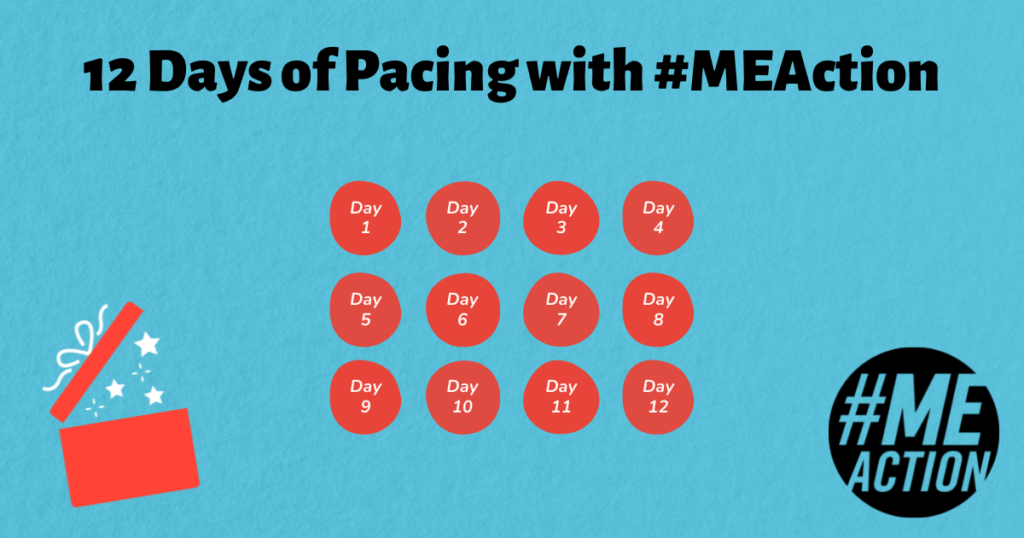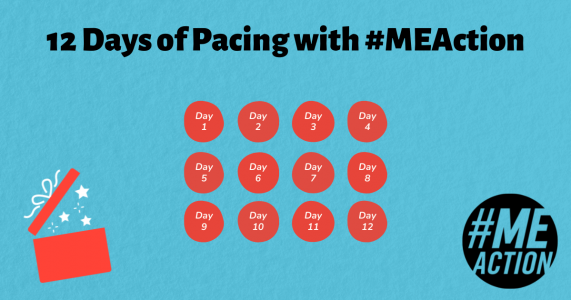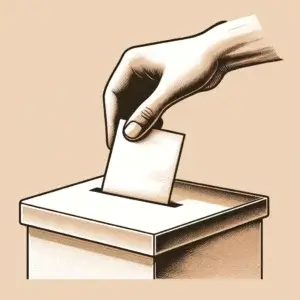12 Days of Pacing Begins Today!

Welcome to #MEAction’s 12 Days of Pacing!
For the next 12 days will work through what #StopRestPace really means and how to apply it practically in your life. We are excited to share some great tips from our amazing community along the way. We hope you will view this as a discussion and jumping off point for how to apply “pacing” in your life with ME.
Just remember that we are all different and each person’s version of pacing might look a little different than someone else’s. So whether you are brand new to this illness and the need to pace or if you have been putting this concept into practice for years, we think you will find our 12 days of pacing useful especially as we are now headed into a super busy time of year that has some unusual demands on our time and energy.
We want to keep this short enough to be usable but also provide all the information you need.
Today we will focus on why we need to stop, rest, and pace.
DO NOT FORGET the first two in your efforts to pace – stop and rest.
The cardinal symptom of ME/CFS is post-exertional malaise (PEM). PEM is a flare of symptoms and/or the appearance of new symptoms after exertion, often presenting 24 hours after the triggering event. Physical activity, cognitive overexertion and sensory overload can all
trigger PEM. You might also hear it referred to as post-exertional symptom exacerbation. Post-exertional malaise is a unique symptom. It is NOT THE SAME as being more tired than normal after activity. It can be hard to explain if you have not experienced the full body assault that is PEM.
Unfortunately, a large group of people experiencing Long Covid are now experiencing PEM.
We thought there was a good example shared In a recent article in The Atlantic by Ed Yong. A physiotherapist named Darren Brown along with others shared with Yong “that nothing in their training had prepared them for the total absence of energy they experienced. Fatigue feels flippant, while exhaustion seems euphemistic. “
“It felt like someone had pulled the plug on me so hard that there was no capacity to think,” Brown said. “Moving in bed was exhausting. All I was doing was surviving.” Some days all you do will be to survive.
That is when you should be practicing radical rest. We will touch on that concept more in a later date. Now that you know the why and a bit of the depth of PEM – we can move on to the how in day 2.
Time to hear from you! What do you think of PEM as? Is there one example that helped exemplify it? Do you have a preferred term? As always, pace yourself with your participation. Read and answer when you can and only if you can safely. We are so sorry that you are living with this illness but we are so glad that we have each other. #YouAreNotAlone
Day 2
Welcome back to #MEAction’s 12 Days of Pacing! On day 1 we briefly discussed the why of #StopRestPace and today on day 2 we are moving on to the what! What is pacing?
You might have heard of the word pacing in various contexts- pacing yourself in a marathon, pacing yourself to slowly increase your activity until you have expanded beyond your original limit, you might have even heard of something called the PACE trial. NEWSFLASH: NONE OF THESE ARE PACING DONE IN ME.
Pacing is a self-management strategy for activity. It is not a treatment or a cure. When you pace for ME/CFS you are active when able, and rest when tired. You plan extra rest ahead of activities. You might practice radical rest. It sounds kind of simple when you explain it but it is frustrating and difficult when put into practice especially at first.
The aim of pacing in ME/CFS is to remain as active as possible while avoiding the relapses resulting from overexertion. What can be so frustrating about this is any standard you had before for rest or overdoing it have been obliterated by this illness.
This pacing is different from what you might have heard used in some other illnesses as well. On Day 1 we mentioned Darren Brown, a physiotherapist with Long Covid who was interviewed recently for an Atlantic article by Ed Yong. Brown gives a good example of the difference. “Brown has spent years teaching people with HIV or cancer about pacing themselves, mostly by divvying up energetic tasks throughout the day. But the pacing he needed for his post-exertional malaise “was totally different,” he told me. It meant carefully understanding how little energy he had at any time, and trying to avoid exceeding that limit.”
What you can physically do has just radically changed and that means radical adjustments. That is where pacing comes in. The goal is to do as much as you can SAFELY. Safely just looks a lot different. For more in depth help and to cover more than we can manage in a post, we cannot recommend the pacing guide put together by Jaime Seltzer for #MEAction enough. We will be covering some concepts from the guide in future posts but we are trying to keep each day as manageable as possible. http://www.meaction.net/wp-content/uploads/2021/02/Pacing-and-Management-Guide-for-ME_CFS-9.pdf
On Day 3 and 4 we will be sharing tips from the community that offer practical usable help.
We are excited to get there but we wanted to truly set up the why of pacing and then how radical a change it really is. It is hard to put into words that truly convey the depths to which #StopRestPace can be needed.
We would love to hear your thoughts! How radical was the change from pre-illness activity to life with ME?
Day 3
Time for Day 3 of #MEAction’s 12 days of pacing! We hope the first two days have been helpful in understanding the concept more thoroughly. Today we are excited to share what we think is a very wise tip from community member Eliza Charly. Eliza shared, “Best tip I use (especially during flares & more severe times): single-task my energy (opposite of multitasking). Doing something physical? Then consider not being social at the same time. Talking to someone? Sit/lay down. Micro pace energy, not just activity.”
That tip then inspired Ariel K. to respond with another great tip: “Yes! Swap one sense for another. I keep a set of printouts to show people: ‘I may have to close my eyes/lay down while I listen to you. This will help me conserve energy, and comprehend more of what you’re saying.'”
We think it is brilliant to remember that limiting one type of exertion or taking the pressure off of one or two of your senses can really help manage a task.
How do you put this idea into practice? If you were to keep a printout to show people, what would it say? (Perhaps we can make a few to share during our 12 days!)
This is what we hope happens—that as we share our tips, it will inspire more ideas to be shared and we can all help one another out!
Day 4
Are you ready for day 4 of 12 Days of Pacing? Today we have another helpful tip from the community. In the spirit of pacing, we will be keeping this one short and simple.
We love this tip from Hannah and how relevant it can be to this time of year especially. “If you can only manage part of a social gathering, arrive late and leave at the end. It’s easier than leaving early, you don’t feel you’re missing out as much.”
It can be so tempting to linger especially as your body wears down and getting up to leave begins to seem extra difficult. What tips do you have for gatherings?
Day 5
We have made it to Day 5 of our 12 Days of Pacing! How is it going? Finding it helpful?
Today we want to take time to point you to #MEAction’s Pacing and Management Guide to ME/CFS. Jaime Seltzer, our Director of Scientific and Medical Outreach put together this wonderful tool for our community to use. We also have translations by volunteers in Swedish and Italian. It is beautifully designed to be simple to follow and it covers complicated concepts with precision. Pass it along to all who could use it.
https://www.meaction.net/resource/pacing-and-management-guide/
Tomorrow we are tackling bathing/cleanliness which is a big challenge. So get your tips ready to add!
Day 6
We are at the halfway point in #MEAction’s 12 Days of Pacing – Day 6! Today we will focus on a particularly tricky aspect of pacing- cleanliness/bathing.
Bathing or showering is something many of us did every day without thought before this illness. Suddenly it can change from a task that required no thought or planning to an epic feat of previously unimagined proportions. Depending on your level of illness at any given time, bathing might range from semi-frequent to quite rare. For the most severe, this can mean you no longer bathe or can only bathe a few times a year with help.
The added sensory stimulus, the physical demands of standing and movement, the effects of temperature changes, and so much more all come into play. You might just have to throw out your previous arbitrary standards and embrace a lot of life hacks around bathing.
Some tips that might help:
- Use wipes in between. Find ones that do not aggravate your skin or any sensitivities. Use wettened washcloths if wipes are not for you.
- Invest in a shower chair and handheld showerhead. Standing especially for those dealing with POTS or other dysautonomia adds strain. Try to lessen that strain however you can.
- This one can be difficult but some in our community choose to cut their hair very short to make it easier to keep up with cleaning.
- Play with what water temperature works best for your body. Some do better by bathing with cooler water or at least warm versus hot.
- Take a look around at items you can purchase that might help. An inflatable shampoo basin that a caregiver can use to wash your hair from bed, an inflatable bathtub that can be used with the help of a caregiver, a rinse-free shower cap, etc.
Hopefully being open amongst our community we can help each other get past any feelings of shame or embarrassment.
Please share your helpful tips and hacks! We know as a community we can get very creative. Share away!
Day 7
Day 7 of #12DaysOfPacing is here and today we are discussing heart rate monitoring.
Heart rate monitoring can be a useful tool to help manage PEM. A simple explanation is that you find your “safe” heart rate and stay under it or stay under except for very short intervals with an adequate period of rest in between to help prevent PEM.
For today we are going to share Workwell’s Heart Rate Monitor Factsheet. Workwell is a fiscally sponsored program of a registered nonprofit whose mission is “to focus on research concerning the functional aspects of ME/CFS to facilitate an understanding of the biological basis for fatigue and post-exertional malaise (PEM).”
You can find their helpful factsheet with the information you need to help begin pacing via heart rate monitoring here: https://workwellfoundation.org/wp-content/uploads/2020/03/WW-PEM-Timecourse.pdf
Follow the tips given by Workwell to find your resting heart rate and calculate your anaerobic threshold. Do not spend more than 2 minutes above that heart rate.
You will need to find a device you are comfortable using to accurately monitor your heart rate. Some devices can be programmed to alert the wearer when their heart rate reaches a certain value. Program your device to alert you below the value you have identified as triggering PEM so that you can stop your activity in time. Feel free to share your favorites below!
Your heart rate monitoring might look a little different but this is an excellent starting point to discover what works best for you.
Good pacing practice requires listening to your body and adjusting your practice accordingly. If you continue to develop PEM, you may have to decrease your activity until it no longer induces PEM. Likewise, you may be able to increase your ‘safe’ heart rate if you do not experience PEM at those values. The most important thing is that you are listening to your body.
Has heart rate monitoring helped you?
Day 8
Wow! Day 8 of #12DaysOfPacing – What is the exertion in PEM?
Exertion is defined as anything that stresses or strains the system. Some stressors are within the patient’s control and some are NOT. Identifying triggers for post-exertional malaise is vital to a person with ME’s physical and psychological well-being.
Potential triggers include:
- Physical (exercise)
- Orthostatic (standing for long periods of time)
- Cognitive (long conversations, scholarly reading/writing)
- Sensory (loud, repetitive noises, bright or flashing lights)
- Emotional (challenging interactions, tragic events)
- Environmental (proximity to allergens, changes in weather, seasonal changes)
No trigger can be controlled all of the time. The goal of pacing is to minimize post-exertional malaise, rather than eliminate it. Keeping an activity and symptom diary each day can help identify triggering events.
Post-exertional malaise may be delayed by approximately 24 hours. Anecdotally, these delays are more common in long-standing disease and may increase on a circadian cycle with greater and greater distance between the triggering event and PEM. This is an important consideration when connecting PEM to a triggering event.
Day 9
Today we are having a discussion on the privilege of being able to truly rest & pace with the way our society presently functions. This is a tough conversation but important.
Early in the illness, many of us did not know to #StopRestPace, which is part of why we’re working so hard to get the message out to all those new to ME/CFS & post-exertional malaise now. Once you know about pacing then comes figuring out how to put it into practice in a world that pushes you to keep DOING at all costs.
To truly take care of ourselves and pace, we need support. Some of us have a combination of a supportive network & funds that allow us to do this but many of us do not. For those without support, the pressure to keep up your previous level of activity feels insurmountable without access to social programs that allow you to decrease your exertion levels.
We need our world to do better and we are committed to sharing and participating in efforts from disability rights organizations so we can all work together to improve how disabled people are treated.
In acknowledging the privilege of truly pacing, we also need to recognize that at some point your body will just no longer allow you to continue at that pace. No amount of willpower, perseverance, or sheer determination can keep your ill body functioning at pre-illness levels.
But there is hope. First, we are working to ultimately find a cure and on the way to the cure treatments that actually help. While that is happening, pacing to the best of your ability can help prevent the destruction that comes with overexertion. And that is one reason we are focusing on #12DaysOfPacing & #StopRestPace so we can make a real-life difference right now.
Day 10
Let’s change it up a bit for Day 10 of our #12DaysOfPacing and share a video!
Can we have one moment of your time?
When #MEAction launched the #StopRestPace campaign last year, we knew we needed to reach the multitude of people who have Long COVID who are showing symptoms of ME so they can get the care they need from the beginning.
Our #StopRestPace campaign has already made a difference! Now we need to reach those affected by the new wave of illness coming after the Delta variant of COVID-19. It is time again to mobilize and prevent harm to all those who feel worse after exertion, a symptom known as post-exertional malaise (PEM).
Please continue to share our #StopRestPace video on your social feeds, and encourage the Long COVID community to pace themselves to prevent harm. For more information: https://www.meaction.net/long-covid-me-understanding-the-connection/
Day 11
Can you believe we are already at Day 11 of #12DaysOfPacing? Today, we are sharing some tips that came in from the community on our bathing and heart rate pacing days.
We encourage you to go back and look at the posts and tweets with all the great replies and comments. We can only pull a few out of a massive amount of wisdom shared!
From bathing: (briefly summarized)
- Use a grab bar.
- Have a thick terrycloth robe or large bath sheet to wrap up in immediately after a shower & lie down to dry.
- Install metal baskets to hold shower products at chair height rather than standing height.
- A shower chair with a back helps more than a stool.
For heart rate pacing:
- The best device is the one you will use consistently.
- The most accurate is a chest strap. The wrist devices are getting better as far as features and accuracy.
Have you had any favorite tips so far? Any that you would like to add?
Day 12
We are coming to an end for our #12DaysOfPacing. We hope it got you thinking about how you can pace and that you found some tips that will work for you.
Thank you for your participation and shares! The community is so generous with sharing hard-won wisdom and knowledge.
We would like to end on this note – while we can use pacing to help with symptom management, we want to remind you that it is not your fault your body has this illness. It is not your fault that you are dealing with post-exertional malaise. You are not to blame for a body that is misfiring and causes what is normally a perfectly reasonable activity or demand to expect of a body to turn into payback. Let’s all be careful of the language that we use with ourselves. Instead of “I overdid, so now my body [xyz],” use “My body is malfunctioning and reacts unreasonably to exertion. I can try and pace which can help but it is not my fault that I am sick.”
What do you think? Is there a way you frame your symptoms and pacing that helps?
We are always working to create a better world for all people with ME. We want a cure, treatment, and prevention. Meanwhile, we do all we can to make a real-life difference here and now. We hope the 12 days of pacing and #StopRestPace are helpful for you.
You can see more resources here:






5 thoughts on “12 Days of Pacing Begins Today!”
Went all day without a drink last week as although my husband also with ME was well enough that day to bring me one, I just couldn’t reach out for it. Unplugged. It’s a stupor almost, unsure and not caring if the next breath comes, completely flat battery- and alternator. I even wonder how I might have got out of a burning house….adrenaline already used up on that short visit to see our grandchild. A few zombie days followed – out of bed but capable of nothing more. By day 4 I was able to empty the dishwasher in 2 sessions and brew tea-iow energy tasks. Day 5 I went out locally and someone I know who knows me told me I looked well and proceeded to tell me all about how covid restrictions had stopped them from wedding anniversary plans. I offered my congratulations and smiled, mask intact.
Such a good example of how radically it can effect you and then the slow recovery. Having something within your reach and just being unable to reach and lift it to bring the cup to your mouth is a real struggle. Straws can help if you can have someone leave the cup in the crook of your underarm so you just turn your head a bit. (or at least I have done that)
Day 1 comment- to me, PEM feels like having cement in my veins and a lead blanket (like the dentist puts over you for an X-ray) has descended onto my brain. Thanks for this 12 day series!
I don’t really like the term ‘PEM or Post Exertional Malaise’ because ‘malaise’ seems to downplay how horrible I feel after activity. I much prefer ‘PENE or Post Exertion Neuroimmune Exhaustion’. ‘Malaise’ is such a whimpy term, while ‘Exertion’ is a more severe term that comes closer to describing how I feel after even the smallest of activity that plagues me so. I have been battling ME/CFS for almost 28 years, and I have been housebound and recliner/mostly bedbound for the past 8 years. I have also been trying to survive Long-Covid since March of 2020, plus Breakthrough Covid since right after July 29, 2021. So, I feel the term ‘PEM’ is more a slap in the face. I strongly believe that ‘PENE’ needs to be used instead.
I agree 100% and I never use ‘CFS’ that applies to many illnesses.
I hope you’ll have some better moments!! I’ve had ME for 30 plus years and still can’t PACE. Best wishes, Sally xx
Comments are closed.